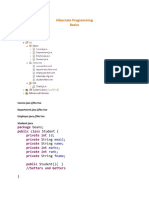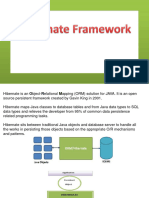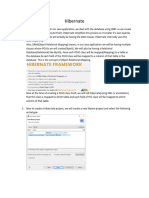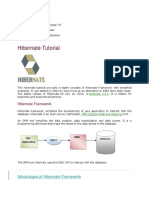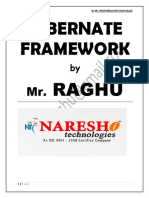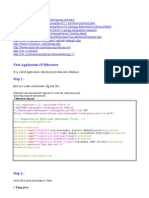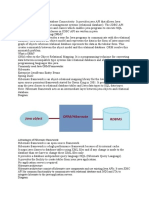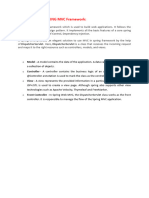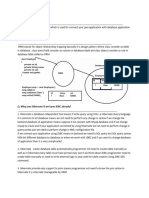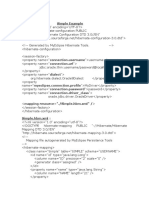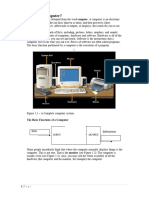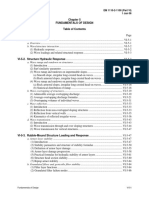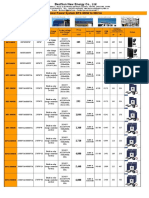Hibernate Framework(part 1)
-by Miss. Geetanjali Gajbhar.
Content:
1. Introduction
2. CRUD using Session Interface’s method
3. Hibernate/Persistence Life cycle
Chapter 1
ORM Tool:
Object Relational Mapping
Hibernate is an ORM tool.
Disadvantages of JDBC and advantages of Hibernate.
Sr.No JDBC Hibernate
Hibernate Framework(part 1) 1
� 1 A lot of boiler plate code NO
In hibernate we use HQL(Hibernate
We use SQL in JDBC which is do
2 query language ) which support
not support OOPs,
OOPS.
3 Low performance than hibernate High performance
Associations like one-to-one, one-
Creating associations between to-many, many-to-one, and many-to-
4
relations is quite hard in JDBC. many can be acquired easily with the
help of annotations.
5 It is a database connectivity tool. It is a Java framework.
JDBC code needs to be written in
Whereas Hibernate manages the
a try-catch databases block as it
6 exceptions itself by marking them as
throws checked exceptions
unchecked.
(SQLexception).
Hibernate Framework:
It is an ORM tool invented by Gavin King in 2001.
Java framework, ORM tool
Hibernate provides methods which replace conventional SQL queries.
Open source
Lightweight(Support POJO classes)
Non-invasive(i.e. App is loosely coupled hence no need to extends or
implements any class/interface).
Internally Hibernate use JDBC.
We can insert or get the data from the table in the form of Object.
Hibernate map the java class with table, and object with the table row.
Mapping:
Java Class→ DB Table
Hibernate Framework(part 1) 2
� Java properties→ Table column
Class Object→ Table row
For mapping we have 2 annotations in Hibernate
@Entity→ To map the class
@Id→ to map the Primary key column
There are 3 ways of Hibernate Mapping
1. XML Approach
2. Annotation based approach (Recommended)
3. Java Based approach (Recommended)
Import all annotations from javax.persistence
import javax.persistence.Entity;
import javax.persistence.Id;
Chapter 2:
CRUD
1. save()
2. get() or load(
3. update()
4. delete()
In hibernate we don’t write SQL queries. We have predefined Methods present
in Session Interface.
Hence With the help of Session object we can call these methods.
We are using XML approach
Hibernate Framework(part 1) 3
� 1.Save the object
Create a new Java Project.
Add Hibernate jar files and MySQL jar files.
How to add the external jar files is explained in JDBC notes.
Create an entity class first:
Note: Maintain Package Structure
package: com.model
package com.model;
import javax.persistence.Entity;
import javax.persistence.Id;
/***************************************
* @Entity is used to map the class with db table.
* @Id is used to set the primary key of the table.
* Java class acts as a table in Db.
* Every variable defined in the class are the column of the tab
* Object of the class acts as row of the table.
**********************************************/
@Entity
public class Student {
@Id
private int id;
private String name;
private String city;
public int getId() {
return id;
}
Hibernate Framework(part 1) 4
� public void setId(int id) {
this.id = id;
}
public String getName() {
return name;
}
public void setName(String name) {
this.name = name;
}
public String getCity() {
return city;
}
public void setCity(String city) {
this.city = city;
}
public Student(int id, String name, String city) {
super();
this.id = id;
this.name = name;
this.city = city;
}
public Student() {
super();
Create Hibernate configuration file at src level
Hibernate Framework(part 1) 5
� hibernate.cfg.xml
<?xml version="1.0" encoding="UTF-8"?>
<!DOCTYPE hibernate-configuration PUBLIC
"-//Hibernate/Hibernate Configuration DTD 3.0//EN"
"http://hibernate.sourceforge.net/hibernate-configuration-3.0.dt
<hibernate-configuration>
<session-factory>
<!-- Connection properties -->
<property name="hibernate.connection.driver_class">
com.mysql.jdbc.Driver</property>
<property name="hibernate.connection.password">root</property>
<property name="hibernate.connection.url">
jdbc:mysql://localhost:3306/test</property>
<property name="hibernate.connection.username">root</property>
<!-- Hibernate properties -->
<!-- db dialect class -->
<property name="hibernate.dialect">
org.hibernate.dialect.MySQLDialect</property>
<!-- to create table -->
<property name="hbm2ddl.auto">update</property>
<!--show sql query -->
<property name="show_sql">true</property>
<!--show sql query in formatted way -->
<property name="format_sql">true</property>
Hibernate Framework(part 1) 6
� <!-- Mapping resources-->
<!-- fully qualified name of pojo class -->
<mapping class="com.model.Student"/>
</session-factory>
</hibernate-configuration>
Test class
package com.model;
import org.hibernate.Session;
import org.hibernate.SessionFactory;
import org.hibernate.Transaction;
import org.hibernate.cfg.Configuration;
public class Test {
public static void main(String[] args) {
//configuration
Configuration cfg=new Configuration()
.configure("hibernate.cfg.xml");
SessionFactory sf = cfg.buildSessionFactory();
Session session = sf.openSession();
Transaction tx=session.beginTransaction();
//create 3 objects of Student
Student s1=new Student(101,"Aman","pune");
Student s2=new Student(102,"Ajeet","Mumbai");
Student s3=new Student(103,"Sameer","Delhi");
//Hibernate methods
session.save(s1);
session.save(s2);
Hibernate Framework(part 1) 7
� session.save(s3);
System.out.println("All data inserted");
tx.commit();
//close the seesion
session.close();
}
}
Check the output on console.
Check the DB automatically table get created. And the object get saved!
Explanation of above program:
1. First of all we have to configure the Hibernate configuration File.
2. Create the configuration file at src level
3. By using configuration object we will get Session Factory object
4. By using Session Factory object we will get session object
5. Session has multiple predefined methods to perform CRUD ex. save, get,
load, update ,delete.
Commonly required Annotations:
@Entity :→Use to make any class an Entity.
@Id →Set as primary key.
@Table →use to change the table details.
@GeneratedValue →We can use this annotation with @ID , Because hibernate will
automatically. generate values for that using an internal sequence. So don’t have
to set it manually.
Hibernate Framework(part 1) 8
� @Column →To change the column name, etc. details.
@Transient →This tells hibernate not to save this field in DB.
@Temporal →It tells hibernate in which format the field needs to be saved.(Ex. Date)
@LOB →tells hibernate that it is a large object.
Example:
package com.model;
import java.sql.Date;
import javax.persistence.Column;
import javax.persistence.Entity;
import javax.persistence.GeneratedValue;
import javax.persistence.GenerationType;
import javax.persistence.Id;
import javax.persistence.Lob;
import javax.persistence.Table;
import javax.persistence.Temporal;
import javax.persistence.TemporalType;
import javax.persistence.Transient;
@Entity
@Table(name="Address_data")
public class Address {
@Id
@GeneratedValue(strategy = GenerationType.AUTO)
@Column(length=20,name="address_id")
private int id;
@Column(length=20,name="address_city")
private String city;
@Transient
Hibernate Framework(part 1) 9
� private String state;
@Lob
private byte[] image;
@Temporal(TemporalType.DATE)
private Date addressDate;
//getter setter
//Construtor using fields
//constructor of parent class
2. Get/Fetch the object
We have 2 methods to get a single row
1. get()
2. load()
Using get()
package com.model;
import org.hibernate.Session;
import org.hibernate.SessionFactory;
import org.hibernate.Transaction;
import org.hibernate.cfg.Configuration;
public class Test_get {
public static void main(String[] args) {
Hibernate Framework(part 1) 10
� //configuration
Configuration cfg=new Configuration()
.configure("hibernate.cfg.xml");
SessionFactory sf = cfg.buildSessionFactory();
Session session = sf.openSession();
//We dont need Transaction object in get operation
//Transaction tx=session.beginTransaction();
//Hibernate methods
Student st=session.get(Student.class,102);
System.out.println(st.getId());
System.out.println(st.getName());
System.out.println(st.getCity());
System.out.println("Data fetched..!");
//close the seesion
session.close();
}
}
Hibernate:
select
student0_.id as id1_0_0_,
student0_.city as city2_0_0_,
student0_.name as name3_0_0_
from
Student student0_
where
student0_.id=?
102
Hibernate Framework(part 1) 11
� Ajeet
Mumbai
Data fetched..!
Using load()
package com.model;
import org.hibernate.Session;
import org.hibernate.SessionFactory;
import org.hibernate.Transaction;
import org.hibernate.cfg.Configuration;
public class Test_get {
public static void main(String[] args) {
//configuration
Configuration cfg=new Configuration()
.configure("hibernate.cfg.xml");
SessionFactory sf = cfg.buildSessionFactory();
Session session = sf.openSession();
//We dont need Transaction object in load operation
//Transaction tx=session.beginTransaction();
//Hibernate methods
Student st=session.load(Student.class,102);
System.out.println(st.getId());
System.out.println(st.getName());
System.out.println(st.getCity());
System.out.println("Data fetched..!");
Hibernate Framework(part 1) 12
� //close the seesion
session.close();
}
}
102
Hibernate:
select
student0_.id as id1_0_0_,
student0_.city as city2_0_0_,
student0_.name as name3_0_0_
from
Student student0_
where
student0_.id=?
Ajeet
Mumbai
Data fetched..!
Q. Difference between Get() and load()
get() load()
If object is not present in DB it will If object is not present in DB it will return
return null. ObjectNotFOundException.
Eager loading: Load every
lazy loading: Load the object only when getter()
object(hit the DB every time when
methods are called. Until then it returns proxy
we call get(). Hence performance
object(do not hit the DB), hence performance is better.
is low
Hibernate Framework(part 1) 13
� 3. Update operation
While updating the data, first get the data and then set the updated value.
package com.model;
import org.hibernate.Session;
import org.hibernate.SessionFactory;
import org.hibernate.Transaction;
import org.hibernate.cfg.Configuration;
public class Test_get {
public static void main(String[] args) {
//configuration
Configuration cfg=new Configuration()
.configure("hibernate.cfg.xml");
SessionFactory sf = cfg.buildSessionFactory();
Session session = sf.openSession();
Transaction tx=session.beginTransaction();
//Hibernate methods
Student st=session.get(Student.class,102);
System.out.println(st.getId());
System.out.println(st.getName());
System.out.println(st.getCity());
System.out.println("Data fetched..!");
//update
st.setCity("Nagpur");
session.update();
tx.commit();
//print updated object
Hibernate Framework(part 1) 14
� Student st1=session.get(Student.class,102);
System.out.println(st.getId());
System.out.println(st.getName());
System.out.println(st.getCity());
System.out.println("Data updated..!");
//close the seesion
session.close();
}
}
Hibernate:
select
student0_.id as id1_0_0_,
student0_.city as city2_0_0_,
student0_.name as name3_0_0_
from
Student student0_
where
student0_.id=?
102
Ajeet
Mumbai
Data fetched..!
Hibernate:
update
Student
set
city=?,
name=?
where
id=?
102
Ajeet
Hibernate Framework(part 1) 15
� Nagpur
Data updated..!
Delete operation
package com.model;
import org.hibernate.Session;
import org.hibernate.SessionFactory;
import org.hibernate.Transaction;
import org.hibernate.cfg.Configuration;
public class Test_get {
public static void main(String[] args) {
//configuration
Configuration cfg=new Configuration()
.configure("hibernate.cfg.xml");
SessionFactory sf = cfg.buildSessionFactory();
Session session = sf.openSession();
Transaction tx=session.beginTransaction();
//Hibernate methods
Student s4=new Student(104,"kartik","Surat");
session.save(s4);
System.out.println("data saved");
//delete
session.delete(s4);
tx.commit();
Hibernate Framework(part 1) 16
� System.out.println("Data Deleted..!");
//close the seesion
session.close();
}
}
data saved
Hibernate:
insert
into
Student
(city, name, id)
values
(?, ?, ?)
Hibernate:
delete
from
Student
where
id=?
Data Deleted..!
What is Session Factory(I)?
It is an Interface.
We will get Session(I) object from SessionFactory(I)
What is a Session(I)?
Hibernate Framework(part 1) 17
� It is an Interface which contains the methods like→
get(), load(), update(), delete() etc.
What is Transaction(I) ?
We need Transaction for save/update/delete operation, not in get operation.
We will get Transaction object from session object.
Chapter 3
Hibernate/Persistence Object Life cycle
We can save the object in the DB as a row using Hibernate.
There are 4 states of the Session object.
1. Transient state
2. Persistent State
3. Detached State
4. Removed State
Transient State
When the object is not associated with Session and Database. Then that is a
Transient state of object.
In transient state we just create the object and initialize it.
Persistent State
When the object is associated with Session and Database. Then that is a
Transient state of object.
Hibernate Framework(part 1) 18
� When we call the session.save(object) method, then object will be the part of
persistent state.
Detached State
When the object is not associated with Session but it is the part of Database.
Then that is a Transient state of object.
When we call session.close() then object will be the part of detached state.
Removed State
When the object is associated with Session but it is not the part of Database.
Then that is a Transient state of object.
When we call session.delete(object) method, then object will be the part of
removed state.
Hibernate Framework(part 1) 19

